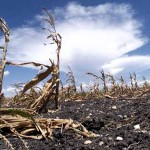A quarter of the world’s food crops are now being grown in regions that are highly water-stressed, according to a report released yesterday by the nonprofit World Resources Institute (WRI). It gets worse: Half the planet’s irrigated cropland, which produce 40% of the global food supply, is located in areas facing severe water shortages as climate change exacerbates drought.
Archive for the ‘Water Shortages’ Category
Worst U.S. drought in decades continues
Sunday, November 25th, 2012The worst US drought in decades has deepened again after more than a month of encouraging reports of slowly improving conditions, a drought-tracking consortium said today, as scientists struggled for an explanation other than a simple lack of rain.
While more than half of the continental US has been in a drought since summer, rain storms had appeared to be easing the situation week by week since late September. But that promising run ended with today’s weekly US Drought Monitor report, which showed increases in the portion of the country in drought and the severity of it.
The report showed that 60.1 per cent of the lower 48 states were in some form of drought as of Tuesday, up from 58.8 per cent the previous week. The amount of land in extreme or exceptional drought the two worst classifications increased from 18.3 per cent to 19.04 per cent.
The Drought Monitor’s map tells the story, with dark red blotches covering the center of the nation and portions of Texas and the Southeast as an indication of where conditions are the most intense. Those areas are surrounded by others in lesser stages of drought, with only the Northwest, Florida and a narrow band from New England south to Mississippi escaping.
– more… ➡
A Cut-and-Dry Forecast: U.S. Southwest’s Dry Spell May Become Long-Lasting and Intensify as Climate Change Takes Hold
Thursday, December 16th, 2010A new analysis using a standard drought index augurs that by the end of the century devastating drought conditions will take hold over much of the populated areas of the world
Lake Mead, the massive reservoir created in the late 1930s by Hoover Dam on the Arizona–Nevada border, has dropped to its lowest level ever, it was reported earlier this month. The lake has been steadily growing shallower since drought began reducing the flow of its source, the Colorado River, starting in 2000 due to below-average snowfall in the Rockies.
It is still too early to know whether the situation at Lake Mead and recent droughts throughout the U.S. Southwest are due to anthropogenic global warming, says Aiguo Dai, an atmospheric scientist in the Climate and Global Dynamics Division of the National Center for Atmospheric Research in Boulder, Colo. There is not enough data to rule out natural variability as the fundamental cause. But the decadelong dry spell is consistent with the predictions of models used in the Intergovernmental Panel on Climate Change (IPCC) Fourth Assessment Report (AR4) in 2007, which projected that warming of the planet would lead to long-term drying over the subtropics—the climatic regions adjacent to the tropics, ranging between about 20 and 40 degrees north and south latitude, which includes the Southwest.
It’s also consistent with a new analysis, authored by Dai, which forecasts that increasing dryness over the next several decades will eventually become devastatingly severe, with long-lasting drought predicted for most of Africa, southern Europe, the Middle East, most of the Americas, Australia, and Southeast Asia. Dai computed global values through the end of the century for a commonly used index of drought severity, using data from 22 models used by IPCC-AR4, under a middle-of the-road emissions scenario that assumes human-generated greenhouse gas emissions start reducing about 2050, and that atmospheric CO2 increases to 720 parts per million (we’re currently at around 380) by the end of the century.
Dai’s projections are helpful because they begin to bring into focus some of the water-related global warming consequences that may be upon us relatively soon, says Richard Seager, a senior research scientist at Columbia University’s Lamont–Doherty Earth Observatory. Seager, who was not part of the study, was a co-author of a 2007 study inScience that analyzed the findings of the IPCC-AR4 models. “When the IPCC report came out in 2007, there was relatively little that looked at how these climate changes developed within the coming decades,” he says. But in Dai’s new figures, “you can see that even in the coming decades or so we’re already getting into some trouble in this regard.”
– More… ➡
Water map shows billions at risk of ‘water insecurity’
Wednesday, November 17th, 2010About 80% of the world’s population lives in areas where the fresh water supply is not secure, according to a new global analysis.
Researchers compiled a composite index of “water threats” that includes issues such as scarcity and pollution.
The most severe threat category encompasses 3.4 billion people.
Writing in the journal Nature, they say that in western countries, conserving water for people through reservoirs and dams works for people, but not nature.
They urge developing countries not to follow the same path.
Instead, they say governments should invest in water management strategies that combine infrastructure with “natural” options such as safeguarding watersheds, wetlands and flood plains.
The analysis is a global snapshot, and the research team suggests more people are likely to encounter more severe stress on their water supply in the coming decades, as the climate changes and the human population continues to grow.
They have taken data on a variety of different threats, used models of threats where data is scarce, and used expert assessment to combine the various individual threats into a composite index.
The result is a map that plots the composite threat to human water security and to biodiversity in squares 50km by 50km (30 miles by 30 miles) across the world.
– More (including the map)… ➡
Nature’s sting: The real cost of damaging Planet Earth
Wednesday, October 27th, 2010You don’t have to be an environmentalist to care about protecting the Earth’s wildlife.
Just ask a Chinese fruit farmer who now has to pay people to pollinate apple trees because there are no longer enough bees to do the job for free.
And it’s not just the number of bees that is dwindling rapidly – as a direct result of human activity, species are becoming extinct at a rate 1,000 times greater than the natural average.
The Earth’s natural environment is also suffering.
In the past few decades alone, 20% of the oceans’ coral reefs have been destroyed, with a further 20% badly degraded or under serious threat of collapse, while tropical forests equivalent in size to the UK are cut down every two years.
These statistics, and the many more just like them, impact on everyone, for the very simple reason that we will all end up footing the bill.
Costing nature
For the first time in history, we can now begin to quantify just how expensive degradation of nature really is.
A recent, two-year study for the United Nations Environment Programme, entitled The Economics of Ecosystems and Biodiversity (Teeb), put the damage done to the natural world by human activity in 2008 at between $2tn (£1.3tn) and $4.5tn.
At the lower estimate, that is roughly equivalent to the entire annual economic output of the UK or Italy.
A second study, for the UN-backed Principles for Responsible Investment (PRI), puts the cost considerably higher. Taking what research lead Dr Richard Mattison calls a more “hard-nosed, economic approach”, corporate environmental research group Trucost estimates the figure at $6.6tn, or 11% of global economic output.
This, says Trucost, compares with a $5.4tn fall in the value of pension funds in developed countries caused by the global financial crisis in 2007 and 2008.
Of course these figures are just estimates – there is no exact science to measuring humans’ impact on the natural world – but they show that the risks to the global economy of large-scale environmental destruction are huge.
– More… ➡

